
Dan Jones
Shared posts
Web Pages Will Soon Load Even Faster in Google Chrome

Bigger data savings are the way for users of Google Chrome and, potentially, other browsers too.
It’s all thanks to a new, open-source HTTP compression algorithm called Brotli, which Google announced last year.
“The smaller compressed size [using Brotli] allows for better space utilization and faster page loads”, say Google.
HTTP compression is used by most web servers and web browsers to improve the transfer speed of core page assets like HTML, CSS and Javascript, helping to save on bandwidth.
Brotli can reduce the size of these assets, which in turn makes them transfer quicker. Net result: faster web.
Brotli Is Ready to Br-eak Out
The byte-crunching feature is nearing arrival in Google Chrome, says Google’s Ilya Grigori on Google+. The search giant is about almost ready to make Brotli “available as a Content-Encoding method, advertised via Accept-Encoding; br”.
Unlike the Google data saver extension launched last year Brotli works behind the scenes and not as a proxy. It currently only works over HTTPS connections, and only where web developers are supporting it (Google Web Fonts already does, for example).
Developer interest in the new format is said to be high, with ‘CDN vendors, tier1 web properties, third parties, and NGINX modules’ all cited by Google.
Brotli is as much 26% better at overall compression over Zopfli, the name of the incumbent algorithm used by Chrome. Brotli currently only works on HTTPS connections but outperforms gzip for html, javascript and css payloads by as much as 25%.
For desktop users that increase will translate into faster page loads. Mobile users with data plans or data caps will also save data, battery life and, potentially, money.
Opt In
If you’re running Google Chrome on beta, dev or canary channels on any platform, including Android and Linux, you can opt-in to the Brotli demo early by visiting:
chrome://flags#enable-brotli
Be aware that while the compression algorithm is designed for HTTP content encoding it currently only works over HTTPS.
Google hopes that other major browsers will join it and Mozilla in adopting the efficient format, reasoning: “[…] the smaller compressed size would give additional benefits to mobile users, such as lower data transfer fees and reduced battery use.”
The article Web Pages Will Soon Load Even Faster in Google Chrome was first published on OMG! Chrome!
New LDS Facility Issue Reporting App
 Facilities Issue Reporting (FIR) is an application that allows LDS unit leaders to report issues to local facilities management. A leaky faucet, a damaged wall, and a malfunctioning heating or cooling system are just a few examples of the maintenance work performed by local facilities management.
Facilities Issue Reporting (FIR) is an application that allows LDS unit leaders to report issues to local facilities management. A leaky faucet, a damaged wall, and a malfunctioning heating or cooling system are just a few examples of the maintenance work performed by local facilities management.
FIR simplifies the interactions between facilities management offices and local ecclesiastical leaders. It enables leaders to submit, track progress of, and view details of facilities issues in their respective buildings. Facilities managers can easily and instantly provide updates to unit leaders through the application.
FIR has now released a mobile app to make reporting facility maintenance issues easier. The app is currently available in English for the USA and Canada. Download the app for Apple iOS and for Android. Throughout 2016, the mobile app will be released to more localities and in additional languages.
You can also report facilities issues online at lds.org/fir.
- Learn more about FIR.
- Read the full release notes.
Here is a list of the leadership positions authorized to report facilities issues:
- Stake/District: President, First Counselor, Second Counselor, Clerk, Executive Secretary, clerks, High Councilor, Stake PFR, Physical Facilities Representative.
- Ward/Branch: Bishop/Branch President, First Counselor, Second Counselor, Executive Secretary, clerks, Elders Quorum President, ward council members, Ward Building Representative.
- Other: Various positions in facilities management offices, area offices, Family History Centers, temples, missions, LDSFS offices, seminaries, institutes, bishops’ storehouses and other welfare locations, distribution services locations,
Luigi to the Rescue!
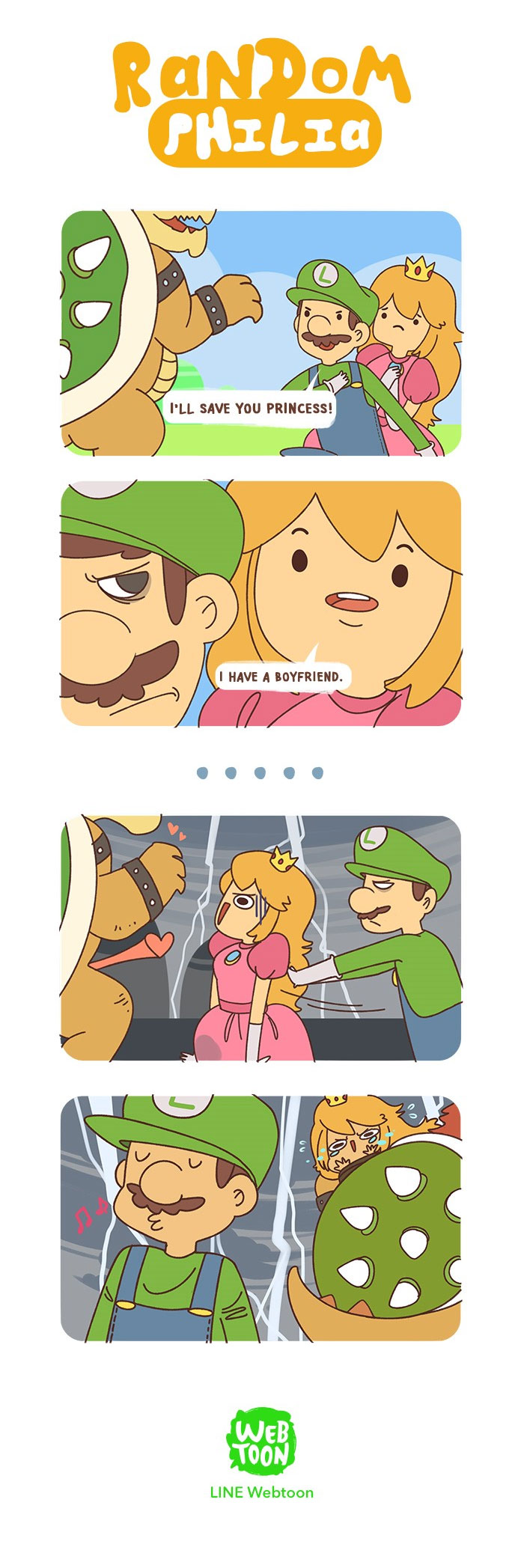 Please tell me that Bowser's heart is just a little lower than everyone else's and that's all it is. Also, did Princess Peach wet herself in the third panel?
Please tell me that Bowser's heart is just a little lower than everyone else's and that's all it is. Also, did Princess Peach wet herself in the third panel?See more: Luigi to the Rescue!
Google Play Free Song of the Day 1/18/2016
21 Classic Rock Favorites (Entire Album)
By
Various Artists
About the artist
They may ask for credit card information through Google Play, but it is 100% completely FREE and you will not be charged!
ADDITIONAL INFORMATION
Deal: Nexus Player at Best Buy for $50
Looking for a deal to brighten up your Monday? Today only, Best Buy is offering Google’s Nexus Player for a mere $50, cutting the regular $100 price tag in half. In addition to the low sale price, it also comes with free standard shipping to your home, making it a breeze to purchase. The Nexus Player is hard to come by these days, so to find it for such a low price is a bit astonishing and should also be reason enough for buying it on an impulse.
The Nexus Player is Google’s first set-top box with Android TV, designed to hit off the launch of Android TV. The device is small, simple and round and comes with a remote to control it. It’s simple enough to set up, requiring only an HDMI port, a power outlet and an Internet connection. From there, you can use the Nexus Player to stream movies and TV shows, listen to music, play games and even cast content from your smartphone in the same way that you’d use a Chromecast.
While it may not pack as many bells and whistles as other set-top boxes, the Nexus Player serves its purpose well and is an absolute steal for $50. Follow the source link below to purchase one for yourself.
Star Wars / Winnie the Pooh Mashup Fan Art 'Wookiee the Chew'
Star Wars / Winnie the Pooh Mashup Fan Art 'Wookiee the Chew'
Relentlessly cheerful artist James Hance recently expanded on his amazing "Wookiee the Chew" Star Wars / Winnie the Pooh mashup art series! Hance's adorable illustrations reimagine Chewbacca as Pooh Bear and Eeyore as an Imperial Walker, along with other crossovers. You can check out his website to see more of his work, and it can be purchsed as t-shisrt and prints in his TeePublic or Etsy stores!














Artist: James Hance - TeePublic Store - Etsy Store
(via: Bored Panda)
Follow us on:
January 18 2016
There’s an App for That
 Professionally, I develop both websites and mobile applications for various companies. While I do appreciate the potential opportunities of better speed from mobile applications, I do still prefer the flexibility of a responsive website design that can support any device size. Plus, you don't have to submit and wait in Apple's queue for a simple text change. For that Google isn't as bad, but their lax quality assurance has also contributed to Google Play being littered with crap apps.
Professionally, I develop both websites and mobile applications for various companies. While I do appreciate the potential opportunities of better speed from mobile applications, I do still prefer the flexibility of a responsive website design that can support any device size. Plus, you don't have to submit and wait in Apple's queue for a simple text change. For that Google isn't as bad, but their lax quality assurance has also contributed to Google Play being littered with crap apps.On a side note, did you know that Apple trademarked the phrase "There's an App for That" back in December of 2009? It's true and expected, too.
See more: There’s an App for That
Batman v. Superman Rock Em Sock Em Robots

I don't know why these two kids can't just get along. Buuuuut...since they can't...let's help them beat the crap out of each other. Some enterprising entity has created a duo of Rock Em Sock Em Robots to complement the upcoming Batman v. Superman: Dawn of Justice movie. It might be one of the best movie merchandising ideas ever.
Like the original game, 2 players duke it out in a battle of brute force backed by sweet punch, smash, and crash sound effects. But this 2016 Rock Em Sock Em Batman v. Superman shakeup makes a few changes, including trading out the boxing ring for a pair of broken earth platforms, and determining each round's winner by knocking one of the superheroes off his platform (as opposed to knocking his head off his neck--bummer).
Batman v. Superman Rock Em Sock Em Robots require superior thumb dexterity for success. Each player holds onto a pair of posts behind their superhero and thumbs the buttons on top to deliver right hooks, left jabs, and full-body shifts to the left and right.
Pearls Before Swine: Sunday, January 17, 2016
Dan JonesCheese would probably be my third to last, rather than my last.

Why I Love Disneyland and Why I Hate that I Love Disneyland
 |
| I carried her all the way back to the hotel like this. |
 |
| "Dad, can we go to Disneyland?" "Maybe next year." |
Hey peeps! :]This is actually on of the comics I’ve made for...
Dan JonesCool concept










Hey peeps! :]
This is actually on of the comics I’ve made for Webtoon, and you should totes visit me there if you have a moment:
If you haven’t seen those yet, enjoy! And thank you for reading.
~Shen
Netflix's VPN Ban Isn't Good for Anyone — Especially Netflix

Slide: 1 / of 1 .
Caption: JOHN G. MABANGLO/epa/Corbis
 JOHN G. MABANGLO/epa/Corbis
JOHN G. MABANGLO/epa/Corbis
After expanding to nearly ever country in the world, Netflix is already in danger of alienating its international audience.
Earlier this month, Netflix made its service available in 130 new countries—that is, almost everywhere around the globe with the notable exception of China. But fast on the heels of its expansion, the company last week shocked international users by announcing plans to crack down on the millions of people estimated who access Netflix via what’s known as a proxy server or virtual private network (VPN), which allow users to mask their locations.
The outcry was swift:
For users abroad, Netflix in, say, Portugal, Poland, or South America isn’t exactly Netflix as Americans know it. Even the offerings in the UK, Ireland, and Canada are significantly more limited than what we in the US have. Netflix has long known that the path to growing its global audience isn’t just making its streaming service available in a country—it also needs to offer the stuff that people in that country want to watch. But until now, this problem wasn’t a huge issue: International users have happily paid for Netflix and used VPNs to get access to Netflix’s content in the US despite Hollywood’s groans over its content licenses.
Now Netflix is saying, no longer. The company plans to begin blocking VPN proxies in the coming weeks in an effort to show studios and networks that it will, in fact, protect their content and abide by licensing deals. International Netflix users are furious, and proxy service providers are already preparing for the worst. (Some providers, in fact, blatantly advertise that their service is for watching Netflix’s U.S. version.) Netflix will likely be able to restrict some access, providers say. But motivated users may still find ways around the ban. And, for Netflix, it might not be worth fighting that hard anyway.
After all, Netflix’s international audience is the key to the company’s future growth. As investors scrutinize Netflix’s strategy after its quarterly earnings report next week, Netflix will likely facing questions about how expanding its service internationally will work on the ground. The real question isn’t whether Netflix is available in 190 countries. The question is when all 190 countries will get the same Netflix.
Cat and Mouse
Netflix’s upcoming strategy for blocking those who use proxies is not yet clear. “Some members use proxies or ‘unblockers’ to access titles available outside their territory. To address this, we employ the same or similar measures other firms do,” David Fullagar, the company’s vice president of content delivery architecture, said in a blog post. “This technology continues to evolve and we are evolving with it.”
A Netflix spokeswoman told WIRED she could not share further details “for obvious reasons.”
“People will always try and find ways to get the content they want no matter the technological barriers,” she said. “We recognize that, and that’s why we are trying to offer our content to members globally at the exact same time.”
But even if Netflix says it will be blocking VPN users, can it? “There’s some low hanging fruit they can get,” says Karl Kathuria, the CEO of Psiphon Inc, which runs proxy technologies for users in countries that censor the Internet like Iran and China. “If it’s a standard VPN with one or ten servers, then it can be pretty easy for them to see what the IP addresses are and block them.”
Netflix could also track whether individual users are regularly logging in from different locations, Kathuria says, which could signal they’re using a VPN.
“But once you get past the standard VPN, the ones that have a limited infrastructure, after that, it’s going to start to get a bit more difficult,” he says. And the question is whether it will be something they could enforce.
Netflix is also not the first company to try to restrict access to its content. “Back in 2014, Hulu tried to cut off access for people living outside the US by blocking VPNs and proxies,” says Faraz Ali, digital marketing manager for PureVPN. “But they did not succeed because many VPN providers found other ways to bypass the restrictions. Everyone knows that Hulu failed.”
Ali and other VPN providers were confident that workarounds could be set up within just a few weeks. “[If] Netflix blocks our server’s IP addresses, we are able to replace our server IPs just as readily,” Ali says. “And if they have a plan to block the entire network, we are able to replace it in matter of days to get around the blockage.”
If providers are able to build workarounds, Netflix will have to commit significant energy (and money) to fighting off users who try to keep using them. “It is more or less a game of cat and mouse,” says Andrew Lee, a digital rights activist and the founder of provider Private Internet Access. “The cat catches the mouse. The mouse, in order to get around this, creates 1,000,000 mice and becomes anonymous due to the sheer number of mice.”
“Go in the sewer in New York and you’ll see that you can’t tell one mouse from another,” he adds. “They all seem the same. However, they are all different.”
TV Without Borders
The Catch-22 is that international users do want Netflix, and they’re even willing to pay. “The irony is that we, and all the other proxy services, built up the international user base, and Netflix knowingly did not aggressively block us from doing it,” Robert Stone, a partner at unblocker MediaHint, says.
“The backlash is already growing and users are going to realize very fast that the service they pay 8 Euros for is nowhere as complete as the $8 in the U.S. service,” Stone adds. “Same price, lousy catalog.”
International users want Netflix the way it was intended to be—a mix of originals, Hollywood films, and TV shows. A splintered service doesn’t work. It needs all the stuff to be good—to be Netflix. “We have seen massive growth in VPN sales since right after the launch of Netflix across the globe because people are aware that VPN means access to the entire Netflix library,” Ali says. “In my opinion, blocking VPN services might affect Netflix regional profits because less content is available.”
The thing is, a truly global service is what Netflix wants, too. Its subscription model guarantees that its interests and the interests of its audience are aligned. The more Netflix is able to offer what viewers want, the more who will subscribe to Netflix.
But for now, even if we idealistically think of the Internet as border-free, the reality is that content isn’t free to roam. Movies and TV shows are still bound by licensing restrictions tied to deals inked years ago, creating a fragmented global landscape to serve studio and network distribution strategies.
“We think the only solution for them is to offer all of their content everywhere,” Ali says. That’s what everyone may want, including Netflix. But for now at least, even Netflix can’t always get what it wants.
Go Back to Top. Skip To: Start of Article.On Release
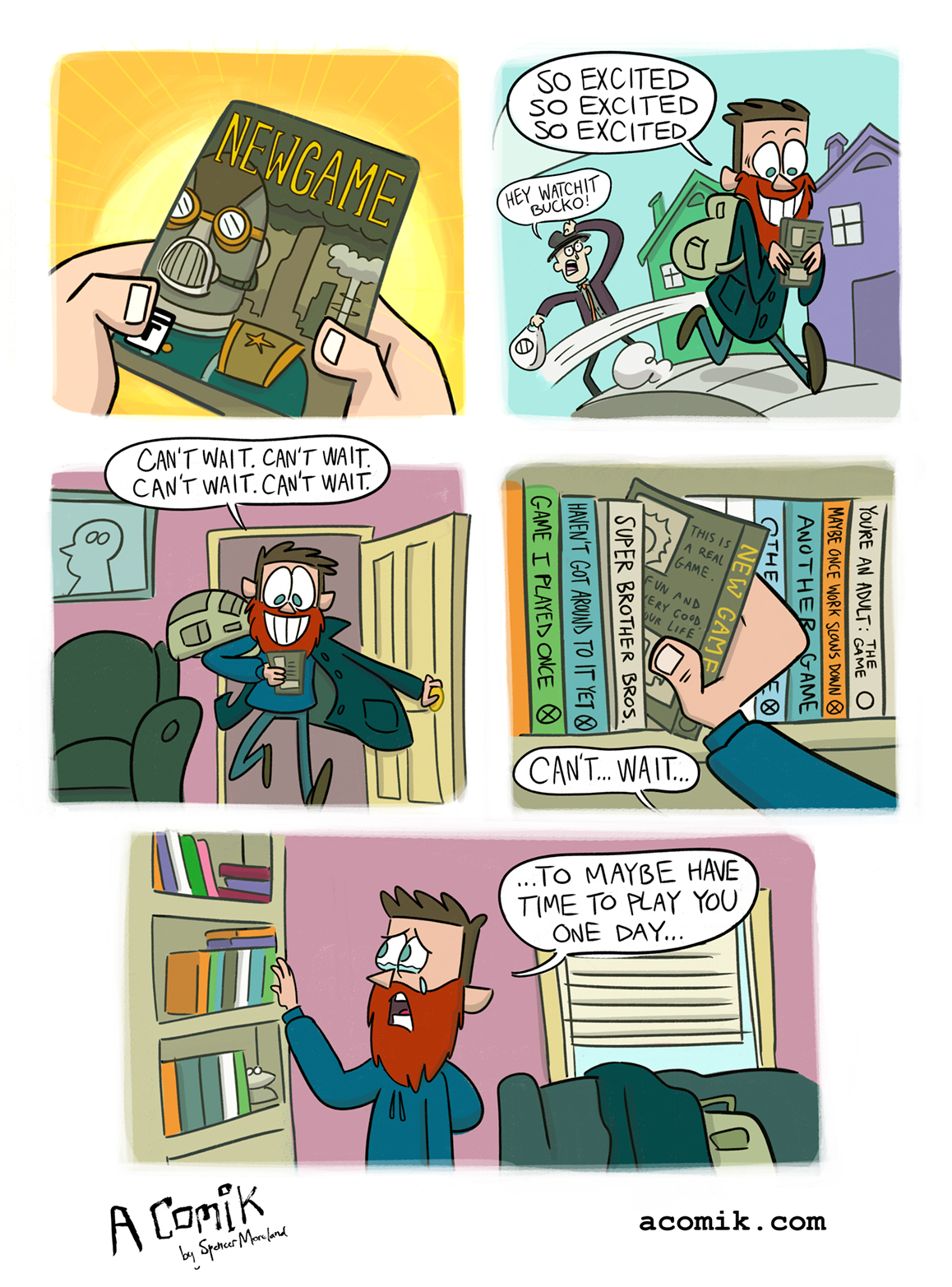 I've seen this premise before. Good comic, nonetheless.
I've seen this premise before. Good comic, nonetheless.See more: On Release
El Niño Is Helping To Solve California's Drought Crisis
January 15, 2016 by Anne Brice
Just last year, researchers were saying there was no end in sight for California's recent drought. During the past four years—the driest the state has been in a half-century— reservoirs and lake levels plummeted, leaves on giant trees grew brittle, plants shriveled and groundwater was depleted through excessive pumping for agricultural use.
But things are looking up. El Niño has swept into the Golden State and is breathing life back into the area. To many, it might seem that this storm front could end the drought and set California back on track. And it is making a difference, but like all things climate-related, it's complicated and hard to predict.
Berkeley News spoke with Berkeley professor B. Lynn Ingram, a geologist specializing in paleoclimatology, who studies past climate history by examining natural archives—trees, sediments, shells, microfossils—and takes a long-term perspective to predict what the climate could have in store for us.
Is this the most rain the state has seen since the drought began four years ago?
B. Lynn Ingram: Yes—some regions have gotten more rain this water year (which began Oct. 1) than they did for the entire water year of 2014-15. Lower than average precipitation in December, followed by much higher precipitation in January to March or April, is a common pattern with strong El Niños. In 1982-83 and 1997-98 [the other two wettest years in recent history], December had lower than average precipitation, but then starting in January, rainfall was much higher than average and continued for months. We're seeing the same pattern this year. Based on the 1997-98 event, we can expect to see precipitation levels around 170 percent of normal for the state. In northern California, it has already rained 20 inches, compared to an average of about 39 inches each year for the past four years.
Shasta Lake, a reservoir in Shasta County, had dropped to lower than 20 percent capacity by May 2015. But reservoirs are filling back up with this year’s El Niño. (Flickr photo by torroid
Will this season's El Niño end the drought?
No. We're in a water deficit of at least two years in most of California. This means we would need more than a year of precipitation like this. We'd probably need more like two years to restore it.
How likely is this to happen?
It's not likely we'll come out of this drought. With climate change, California and the Southwest are predicted to get drier overall with warmer weather and, subsequently, more evaporation. Even with a wetter season this year, even next year, the climate is very likely to continue to be drier. Some are predicting another La Niña next year, which could offset the positive effects of this year's El Niño.
Groundwater in the Central Valley has become extremely depleted from pumping for agricultural use. Credit: Don Barrett
How do meteorologists determine when we're out of a drought?
Being out of a drought means restoring water levels in all the places that water is stored—natural lakes, reservoirs and the ground—to the long-term average. The groundwater is another story because it's been pumped so much. There's no way we're going to replenish that in two years.
Although the drought won't end this season, what are some of the positive impacts of El Niño?
The rain itself is already filling the reservoirs. Statewide, the reservoirs had dropped to 45 percent of the historical average. It's hard to predict how much they'll fill up by the end of the season because it depends how much it rains and how much runoff goes into the reservoirs—in a drought, the rain doesn't produce as much runoff because it's first permeating into the dry ground. By the end of this season, reservoirs could be halfway there, maybe up to 70 percent.
The snowpack is already above average statewide, at about 105 percent, so going into spring and summer, the snow will melt and continue to fill up the reservoirs, so that'll carry over into the summer and fall.
During the flood of 1861-62, the biggest flood on record in California, Sacramento was underwater and the Legislature had to temporarily move to San Francisco. Credit: California State Library
El Niño will also help replenish some groundwater, even though levels won't go back to normal. That would take many, many years. In some places in Southern California and the Central Valley, they're diverting water into storage ponds to allow the water to sink back into the aquifers to recharge the groundwater.
Do you expect to see any flooding in the next few months?
When you get heavy rainfall, you definitely get more flooding, as well as landslides and mudflows. This is especially true in California, which has steep slopes that are generally pretty unstable. During droughts, soil and vegetation dry out, and there are more wildfires, so the land is more susceptible to erosion, landslides and mudflows. Another cause of flooding is atmospheric rivers.
What are atmospheric rivers?
Atmospheric rivers occur when corridors of water vapor come up from the tropics, traveling across the Pacific Ocean for thousands of miles to the West Coast. An atmospheric river storm brings really heavy rain and it's warm because it's coming from the tropics, so that means it falls more as rain in the mountains (as opposed to snow), so you actually get more runoff filling the Central Valley. That's why they cause more flooding than regular, colder storms. Most of our major floods in California correspond to these atmospheric river storms. But they're really important because, on average, they provide 30 to 50 percent of our water resources in just 10 days a year.
Micro-drip watering systems help to conserve water in agriculture. Credit: USDA
Will the state be hit by an atmospheric river this year?
We normally get several smaller atmospheric river storms every year. So we could get some small ones, which last just two or three days. Stronger atmospheric river storms don't necessarily correspond to El Niño years, however. But we're predicting bigger ones in the future. If we go back in time in geologic records, we see that a big storm (and "megafloods") recurred every 100 to 200 years. The only megaflood on record was in 1861-62, which was the biggest flood on record in California. It filled the entire Central Valley, which is 300 miles long and 20 miles wide, with 10 feet of water. It's been 160 years since that flood, so any given year now, it's a possibility that another will occur. Everyone knows about the big earthquake that might hit the San Andreas, but few people know about these megafloods.
What would the impact be if another big storm hits?
In 1861, the state had 43 straight days of rain. The USGS created a scenario based on this flood, but with only 23 days of flooding, and still the water filled the Central Valley and 25 percent of houses in the state were damaged and 1.5 million people would need to evacuate. It produced $400 billion in damage. It would be a major disaster.
How can people prepare for this disaster when it happens?
Don't buy a house in a flood plain. Already, more than 6 million people live in the Central Valley and that's where all of our future development is slated to take place. It's just crazy to me that they can even continue to build these developments in places that are so susceptible to flooding.
So can we relax our water conservation efforts?
No—right now, our water usage is greater than our water supply. We need to change how we're using water. Not just in conservation, but in water recycling and reusing grey water. We also need to increase efficiency in agriculture by revamping watering systems, and we need to start charging more for water and regulating groundwater. We're the only state that doesn't regulate groundwater. Our groundwater is our bank account and we've been depleting it.
In 2014, Gov. Jerry Brown signed legislation to strengthen local management and monitoring of groundwater basins—the first time in California history—and in March 2015, he announced a billion-dollar drought relief plan. Although some say it could take up to a decade to implement, is this a step in the right direction?
Groundwater is an important reservoir of water, particularly in drought-prone regions like the American West. It is critical to monitor and regulate this critical water resource, so I am encouraged that the state will be doing this in the near future.
B. Lynn Ingram is a professor of earth and planetary science at UC Berkeley. She is the author of The West Without Water: What Past Floods, Droughts and Other Climatic Clues Tell Us About Tomorrow, co-written with geographer and environmental biologist and visiting scholar Frances Malamud-Roam.
![]() Explore further: El Nino could be strongest in modern history: US
Explore further: El Nino could be strongest in modern history: US
More from Earth
Related Stories


El Nino could be strongest in modern history: US
The El Nino weather phenomenon that began this year could be among the strongest in 65 years, US government scientists said Thursday.
El Nino increasing likelihood of wet California winter, though it won't end the drought
The latest observations are clear: A monster El Niño is currently brewing in the Pacific Ocean.


El Nino brings rain to California but won't end drought
The El Nino weather phenomenon is likely to drench California for some time to come and trigger floods, but it still won't end the state's severe drought, experts say.


Meteorologist lifts the fog surrounding El Niño
Based on the latest information from a San Francisco State University meteorologist, now may be a good time to stock up on rain ponchos, rubber boots and umbrellas. The overall consensus among scientists, forecasters and ...


California braces for series of El Nino storms
After all the talk, El Nino storms have finally lined up over the Pacific and started soaking drought-parched California with rain expected to last for most of the next two weeks, forecasters said Monday.


El Nino could gently replenish overstressed aquifers in parched state – or it might ravage vulnerable infrastructure
When respected climatologists describe this winter's warming of tropical Pacific waters as a Godzilla El Nino event, they might be onto something. The science fiction monster's signature move is to emerge from the ocean and ...
Recommended for you


Scientists express concern over disposal of nuclear waste at New Mexico underground salt formation
(Phys.org)—A trio of Earth and Environmental scientists with hazardous waste backgrounds, from Stanford University, has published a Comment piece in the journal Nature, outlining their concern over a recent proposed plan ...


Northwest Atlantic Ocean may get warmer, sooner
A new study by NOAA researchers suggests future warming of ocean waters off the Northeastern U.S. may be greater and occur at an even faster rate than previously projected.


Human-made climate change may be suppressing the next ice age (Update)
Humanity has become a geological force capable of suppressing the beginning of the next ice age, according to a study published in the journal Nature. Cracking the code of glacial inception, scientists of the Potsdam Institute ...


Ice sheets may be hiding vast reservoirs of powerful greenhouse gas
The study indicates that under the frigid weight of Barents Sea Ice sheet, which covered northern Eurasia some 22 000 years ago, significant amounts of methane may have been stored as hydrates in the ground. As the ice sheet ...


Acidification affects the ability of bacteria to clean our oceans
Marine bacteria are heavily influenced by the ongoing ocean acidification caused by human emissions of carbon dioxide. This discovery was made by researchers at Linnaeus University, Sweden, together with researchers in Spain. ...


West Coast study emphasizes challenges faced by marine organisms exposed to global change
The Pacific Ocean along the West Coast serves as a model for how other areas of the ocean could respond in coming decades as the climate warms and emission of greenhouse gases like carbon dioxide increases. This region—the ...
0 comments
Please sign in to add a comment. Registration is free, and takes less than a minute. Read more
Click here to reset your password.Sign in to get notified via email when new comments are made.
© Phys.org 2003 - 2016, Science X network
![]()
January 15, 2016 by Anne Brice
Credit: Kevin Ho Nguyen
Just last year, researchers were saying there was no end in sight for California's recent drought. During the past four years—the driest the state has been in a half-century— reservoirs and lake levels plummeted, leaves on giant trees grew brittle, plants shriveled and groundwater was depleted through excessive pumping for agricultural use.
But things are looking up. El Niño has swept into the Golden State and is breathing life back into the area. To many, it might seem that this storm front could end the drought and set California back on track. And it is making a difference, but like all things climate-related, it's complicated and hard to predict.
Berkeley News spoke with Berkeley professor B. Lynn Ingram, a geologist specializing in paleoclimatology, who studies past climate history by examining natural archives—trees, sediments, shells, microfossils—and takes a long-term perspective to predict what the climate could have in store for us.
Is this the most rain the state has seen since the drought began four years ago?
B. Lynn Ingram: Yes—some regions have gotten more rain this water year (which began Oct. 1) than they did for the entire water year of 2014-15. Lower than average precipitation in December, followed by much higher precipitation in January to March or April, is a common pattern with strong El Niños. In 1982-83 and 1997-98 [the other two wettest years in recent history], December had lower than average precipitation, but then starting in January, rainfall was much higher than average and continued for months. We're seeing the same pattern this year. Based on the 1997-98 event, we can expect to see precipitation levels around 170 percent of normal for the state. In northern California, it has already rained 20 inches, compared to an average of about 39 inches each year for the past four years.
Shasta Lake, a reservoir in Shasta County, had dropped to lower than 20 percent capacity by May 2015. But reservoirs are filling back up with this year’s El Niño. (Flickr photo by torroid
Will this season's El Niño end the drought?
No. We're in a water deficit of at least two years in most of California. This means we would need more than a year of precipitation like this. We'd probably need more like two years to restore it.
How likely is this to happen?
It's not likely we'll come out of this drought. With climate change, California and the Southwest are predicted to get drier overall with warmer weather and, subsequently, more evaporation. Even with a wetter season this year, even next year, the climate is very likely to continue to be drier. Some are predicting another La Niña next year, which could offset the positive effects of this year's El Niño.
Groundwater in the Central Valley has become extremely depleted from pumping for agricultural use. Credit: Don Barrett
How do meteorologists determine when we're out of a drought?
Being out of a drought means restoring water levels in all the places that water is stored—natural lakes, reservoirs and the ground—to the long-term average. The groundwater is another story because it's been pumped so much. There's no way we're going to replenish that in two years.
Although the drought won't end this season, what are some of the positive impacts of El Niño?
The rain itself is already filling the reservoirs. Statewide, the reservoirs had dropped to 45 percent of the historical average. It's hard to predict how much they'll fill up by the end of the season because it depends how much it rains and how much runoff goes into the reservoirs—in a drought, the rain doesn't produce as much runoff because it's first permeating into the dry ground. By the end of this season, reservoirs could be halfway there, maybe up to 70 percent.
The snowpack is already above average statewide, at about 105 percent, so going into spring and summer, the snow will melt and continue to fill up the reservoirs, so that'll carry over into the summer and fall.
During the flood of 1861-62, the biggest flood on record in California, Sacramento was underwater and the Legislature had to temporarily move to San Francisco. Credit: California State Library
El Niño will also help replenish some groundwater, even though levels won't go back to normal. That would take many, many years. In some places in Southern California and the Central Valley, they're diverting water into storage ponds to allow the water to sink back into the aquifers to recharge the groundwater.
Do you expect to see any flooding in the next few months?
When you get heavy rainfall, you definitely get more flooding, as well as landslides and mudflows. This is especially true in California, which has steep slopes that are generally pretty unstable. During droughts, soil and vegetation dry out, and there are more wildfires, so the land is more susceptible to erosion, landslides and mudflows. Another cause of flooding is atmospheric rivers.
What are atmospheric rivers?
Atmospheric rivers occur when corridors of water vapor come up from the tropics, traveling across the Pacific Ocean for thousands of miles to the West Coast. An atmospheric river storm brings really heavy rain and it's warm because it's coming from the tropics, so that means it falls more as rain in the mountains (as opposed to snow), so you actually get more runoff filling the Central Valley. That's why they cause more flooding than regular, colder storms. Most of our major floods in California correspond to these atmospheric river storms. But they're really important because, on average, they provide 30 to 50 percent of our water resources in just 10 days a year.
Micro-drip watering systems help to conserve water in agriculture. Credit: USDA
Will the state be hit by an atmospheric river this year?
We normally get several smaller atmospheric river storms every year. So we could get some small ones, which last just two or three days. Stronger atmospheric river storms don't necessarily correspond to El Niño years, however. But we're predicting bigger ones in the future. If we go back in time in geologic records, we see that a big storm (and "megafloods") recurred every 100 to 200 years. The only megaflood on record was in 1861-62, which was the biggest flood on record in California. It filled the entire Central Valley, which is 300 miles long and 20 miles wide, with 10 feet of water. It's been 160 years since that flood, so any given year now, it's a possibility that another will occur. Everyone knows about the big earthquake that might hit the San Andreas, but few people know about these megafloods.
What would the impact be if another big storm hits?
In 1861, the state had 43 straight days of rain. The USGS created a scenario based on this flood, but with only 23 days of flooding, and still the water filled the Central Valley and 25 percent of houses in the state were damaged and 1.5 million people would need to evacuate. It produced $400 billion in damage. It would be a major disaster.
How can people prepare for this disaster when it happens?
Don't buy a house in a flood plain. Already, more than 6 million people live in the Central Valley and that's where all of our future development is slated to take place. It's just crazy to me that they can even continue to build these developments in places that are so susceptible to flooding.
So can we relax our water conservation efforts?
No—right now, our water usage is greater than our water supply. We need to change how we're using water. Not just in conservation, but in water recycling and reusing grey water. We also need to increase efficiency in agriculture by revamping watering systems, and we need to start charging more for water and regulating groundwater. We're the only state that doesn't regulate groundwater. Our groundwater is our bank account and we've been depleting it.
In 2014, Gov. Jerry Brown signed legislation to strengthen local management and monitoring of groundwater basins—the first time in California history—and in March 2015, he announced a billion-dollar drought relief plan. Although some say it could take up to a decade to implement, is this a step in the right direction?
Groundwater is an important reservoir of water, particularly in drought-prone regions like the American West. It is critical to monitor and regulate this critical water resource, so I am encouraged that the state will be doing this in the near future.
B. Lynn Ingram is a professor of earth and planetary science at UC Berkeley. She is the author of The West Without Water: What Past Floods, Droughts and Other Climatic Clues Tell Us About Tomorrow, co-written with geographer and environmental biologist and visiting scholar Frances Malamud-Roam.
![]() Explore further: El Nino could be strongest in modern history: US
Explore further: El Nino could be strongest in modern history: US
More from Earth
Related Stories


El Nino could be strongest in modern history: US
The El Nino weather phenomenon that began this year could be among the strongest in 65 years, US government scientists said Thursday.
El Nino increasing likelihood of wet California winter, though it won't end the drought
The latest observations are clear: A monster El Niño is currently brewing in the Pacific Ocean.


El Nino brings rain to California but won't end drought
The El Nino weather phenomenon is likely to drench California for some time to come and trigger floods, but it still won't end the state's severe drought, experts say.


Meteorologist lifts the fog surrounding El Niño
Based on the latest information from a San Francisco State University meteorologist, now may be a good time to stock up on rain ponchos, rubber boots and umbrellas. The overall consensus among scientists, forecasters and ...


California braces for series of El Nino storms
After all the talk, El Nino storms have finally lined up over the Pacific and started soaking drought-parched California with rain expected to last for most of the next two weeks, forecasters said Monday.


El Nino could gently replenish overstressed aquifers in parched state – or it might ravage vulnerable infrastructure
When respected climatologists describe this winter's warming of tropical Pacific waters as a Godzilla El Nino event, they might be onto something. The science fiction monster's signature move is to emerge from the ocean and ...
Recommended for you


Scientists express concern over disposal of nuclear waste at New Mexico underground salt formation
(Phys.org)—A trio of Earth and Environmental scientists with hazardous waste backgrounds, from Stanford University, has published a Comment piece in the journal Nature, outlining their concern over a recent proposed plan ...


Northwest Atlantic Ocean may get warmer, sooner
A new study by NOAA researchers suggests future warming of ocean waters off the Northeastern U.S. may be greater and occur at an even faster rate than previously projected.


Human-made climate change may be suppressing the next ice age (Update)
Humanity has become a geological force capable of suppressing the beginning of the next ice age, according to a study published in the journal Nature. Cracking the code of glacial inception, scientists of the Potsdam Institute ...


Ice sheets may be hiding vast reservoirs of powerful greenhouse gas
The study indicates that under the frigid weight of Barents Sea Ice sheet, which covered northern Eurasia some 22 000 years ago, significant amounts of methane may have been stored as hydrates in the ground. As the ice sheet ...


Acidification affects the ability of bacteria to clean our oceans
Marine bacteria are heavily influenced by the ongoing ocean acidification caused by human emissions of carbon dioxide. This discovery was made by researchers at Linnaeus University, Sweden, together with researchers in Spain. ...


West Coast study emphasizes challenges faced by marine organisms exposed to global change
The Pacific Ocean along the West Coast serves as a model for how other areas of the ocean could respond in coming decades as the climate warms and emission of greenhouse gases like carbon dioxide increases. This region—the ...
0 comments
Please sign in to add a comment. Registration is free, and takes less than a minute. Read more
Click hereto reset your password.
Sign in to get notified via email when new comments are made.
© Phys.org 2003 - 2016, Science X network
![]()
Barely a few months old, and already caught his first pikachu....

Barely a few months old, and already caught his first pikachu. On his way to becoming a Pokémon master. #Pokemon #Pikachu #Pokemon20 http://ift.tt/1RLnRka
Cam
 What you see is what you get or as the techies say: . I'm still surprised when I use the acronym WYSIWYG and people have no idea what I am talking about. I thought that term would have been a lot more common than it actually is.
What you see is what you get or as the techies say: . I'm still surprised when I use the acronym WYSIWYG and people have no idea what I am talking about. I thought that term would have been a lot more common than it actually is.See more: Cam
The Higher Lower Game
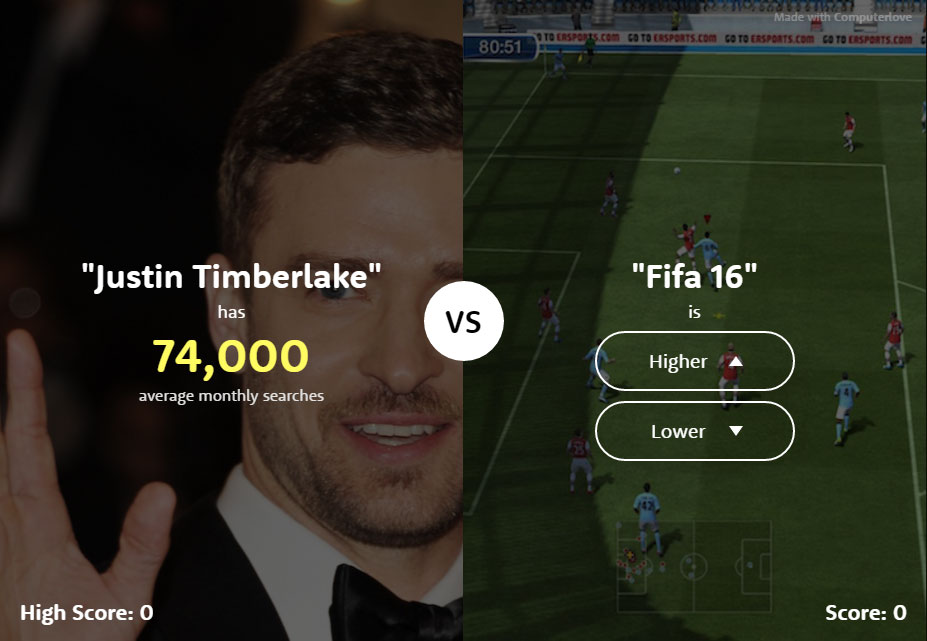 I was informed about The Higher Lower Game yesterday. The concept of the game is simple: will search term B rank higher or lower than search term A. That's it!
I was informed about The Higher Lower Game yesterday. The concept of the game is simple: will search term B rank higher or lower than search term A. That's it!Thing is, I caught myself playing it for a good 15-20 minutes throughout the day. And I thought to myself, if I enjoyed it enough to play it for that long then other people might, too.
So I am resharing what was initially shared with me yesterday. If you enough it too, great! And if you don't, well you still got your money's worth out of it.
See more: The Higher Lower Game
What's in a Name? Nomenclature, File Structure, and How to Save Digital Images
Dan Jones8.3 is stupid, and no one should feel they need to stick to that. And I'm pretty sure that 256 character limit on Windows was only true on FAT32 and not NTFS.
Otherwise, I think this is all really good advice.
Good filenames and filing structures allow you to correctly and easily find each unique image when you need it, even if your photo management software fails. It sounds simple, and it is! In this tutorial you'll learn about what you need in a filename and filing structure, how to establish a system, and use the system unfailingly. You'll learn how to keep your digital images organized and avoid a lot of needless heartache.

That Which We Call a Picture
Cameras and smartphones do a great job of providing unique identifiers to each photo taken. Unless you reset the counter in your device, each new image will be numbered sequentially: IMG_0001, IMG_0002, and so on to IMG_9999, and then the numbering starts over again. That’s a lot of photos before you begin to get conflicts, unless:
- You use more than one camera. Each camera is on its own cycle for image numbering, so both cameras will, at some point, produce IMG_1234. Now you have two different images with the same file name.
- You have your camera set to restart numbering with each newly formatted card. Now you’ve got the problem of the same numbering being used on two cards, both of which could be used in the same shoot if you’re a prolific shooter. In that case, you will not only have two different images with the same file name, you’ll also have two different images with the same file name and the same date.
- You are a prolific shooter and always have your camera out. It won’t take long before you’ve accumulated 9999 images and your camera resets to IMG_0001. Once again, you will have two images with the same file name.
Now, imagine uploading those numbered images into your computer’s basic file manager or into photo management software. The files will certainly line up well by name, and depending upon the file or photo management software you’re using, the files may line up properly by date created, but do you remember if the pictures you took in Amsterdam are IMG_2345 to IMG_5432, or was that the shoot that you did for the newspaper? Was the Mad Hatter’s wedding the one you shot on April 1, 2011 or August 1, 2011?
You can create different folders on your computer for different sets of images: Amsterdam-March 2001, for example, or TheChronicle-StreetFair or Montague-Capulet-Wedding-2011. That works so long as the filing structure makes sense to you months later when you’re in a hurry and the images and folders haven’t become disconnected.

You’re getting my point, I’m sure. And that brings me to the raison d’être of filenames and filing structures: to allow you—and someone who may be taking over for you—to correctly and easily find each unique image when you need it, even if your photo management software fails. It sounds simple, and it is so long as you think about what you need in a filename and filing structure, establish a system, and use the system unfailingly.
Files and Folders as Part of a DAM System
This tutorial describes the guidelines you can use to establish your file naming system (nomenclature) and filing structure. This part of digital asset management must be software agnostic: whatever you set up and use has to work no matter which file or image management software you’re using. So, ideally, think about nomenclature and filing structures before building your DAM system. And once you have your DAM system active, apply filenames to new images before, or as part of, ingesting images into a DAM system.
As we go along, you may have questions about how to name files and how to do that as part of digital asset management. I’ve provided a list of suggested articles and courses for you at the end of the tutorial.

A Picture by Any Other Name: Use Unique and Descriptive Filenames for Images
Before you think about filing structures and folders, establish the nomenclature you’ll use for naming your image files. It’s easiest if you start with that.
There are four rules for naming files:
- The name should be descriptive enough that you can identify the file even without photo browsing software.
- Every file must have a unique name.
- The filename should follow conservative guidelines for naming computer files.
- Record your nomenclature and use it.
1. Make Your Filenames Descriptive
Filenames must help you rapidly sort through a large collection of images from multiple shoots. While you don’t want to add job names or descriptions that are going to make a filename too long and unwieldy, you may want to add some basic information and codes that help to group related images and describe them.
Use the Date the Image was Created: YYYYMMDD
The most basic information you can use in a filename is the date the image was created. Assuming you’ve set the clocks correctly in your cameras, every digital image will have the date created stored in the metadata. Almost all file and photo management software will provide some means of using the date created to name a file. You want to express that date as YYYYMMDD. Use four digits for the year to be internet-friendly and to make it clear that the numbers are a date, not random coding. Build your date in year-month-day order so that your files will sort correctly by date.
Some people recommend using hyphens in the date (YYYY-MM-DD) to make the date easier to read, but I recommend not using hyphens in order to keep your filenames as short as possible. Also, it’s common practice in business and retail environments to express a date with hyphens; however, depending upon where you live, the order could be YYYY-MM-DD or YYYY-DD-MM. Avoid the potential for confusion by using the eight digit system; it has been standardized to express the date in one order. If you have been using hyphens, try it without. You’ll be surprised at how quickly you learn to read the date expressed only as eight digits.
Use the Photographer’s Initials: INI
A common descriptor to use in a filename is the photographer’s initials. If nothing else, by adding your initials to the filename, you are marking the source image as yours. You are also preventing any kind of confusion if anyone handling your image files is also managing photos taken by another photographer. This can happen in commercial environments and is often the case in families when one family member acts as record keeper, managing the photos taken by all family members.
Some photographers like to include their name, not just initials, in an image filename. It’s one way of communicating copyright and it can help with marketing and search engine optimization. If your name is in the image filename, your name goes everywhere the image does. However, using your name instead of initials adds more characters to the filename. So, as with any aspect of digital asset management, think about your end purpose and decide what method suits your purpose best.
Add Client or Shoot Information: CODE
Some photographers will add a short code to the filename to identify the client or shoot. For example, for Dick and Jane Smith’s wedding, you might add WEDDJS or SMIT to the filename. Location photos might get an abbreviated place name added to the filename—NL, for the Netherlands, for example. Some photographers will use more characters, opting for clarity over brevity. The point is not that there is a specific system for describing your images but that you should think about whether you need descriptors in image filenames and if so, what method of describing images works for you. And if you’re going to use descriptors, keep it short.

2. Create Unique Filenames
There are two easy methods of generating unique filenames: use the time a photo was taken or use sequential numbering.
Use the Time the Image was Taken: HHMMSS
Digital cameras make it easy to use time as a unique identifier because digital cameras record the time down to seconds. Use that precise time as a type of image file DNA—HHMMSS—that, in combination with the date, will be a unique code for each image.
There is one situation in which two or more image files may have the same timestamp and so using the timestamp to name files will fail. When you are burst shooting, you are taking more than one image per second. It often happens in sports photography and can inadvertently happen on the most ordinary of shoots if you were quick with the shutter release. All images taken within one second will have the same time stamp and the images will look remarkably similar with only the slightest variation. To distinguish one from another, you have to look for more subtle differences or find a different naming system.
If you are the type of photographer who only rarely has two images with the same time stamp—I took one pair of such images in fourteen years of digital photography—take advantage of the warning system built into all file and photo management software. If you try to give a second file the same name as another file, the software will ask you if you want to want to replace the existing file with the new one, or if you want to give each file a unique name. Choose the option of unique names and your file will be appended with -1, -2, and so on as needed to distinguish each file with the same time stamp. To make sure there is absolutely no confusion, manually go back to the first file with the common name. It will not be appended with a distinguishing number. Add -0 to the filename so all files with the same timestamp have a code that reminds you that the image is part of a collection of different images with the same core filename.
Use Sequential Numbering: 0123
If you regularly shoot in burst mode and so often have clusters of images with the same timestamp, you have two choices: append timestamp-based filenames with a unique identifier (-1, b, etc.) or instead of using HHMMSS in your filename, use sequential numbering: 0001, 0002, and so on. Be sure to use leading zeroes so that your images will be correctly organized in any file management software. Without leading zeroes, some programs will order files as 1, 10, 101, 2, 20, 201, and so on. Also, use enough placeholders in your sequence to ensure you will have unique identifiers throughout the whole shoot. If you’re burst shooting at a hockey game, for example, you’re going to need at least four digit numbering.
I’m not a fan of sequential numbering, but sometimes, it’s what works. If you will be using sequential numbering, keep the following in mind:
- If you are shooting with more than one camera or you use more than one media card at a shoot, it’s easy to unintentionally restart sequencing at 0001 with each media card or as you upload from the second camera. If that happens, you’ve got the problem of either duplicate filenames or a need to append filenames with unique identifiers.
- If you add an identifier to distinguish one camera or card from another, sequential numbering may not align images in the order they were taken. That may not be a problem for you, but it’s something to consider.
- If you are shooting for a client and eliminate some images from the shoot before sharing the images with your client, you can bet that your client will ask about an image in the sequential gap.
- When sequential numbering does not result in clean, sequential ordering of related files, it can be, oh, so tempting, to resolve the problem by renaming the files with new sequential numbering. If you do it, you can bet that you’ll end up duplicating filenames or worse.
Save yourself the hassle and just use HHMMSS as your unique identifier, if you can.

Preserve the Original Image Number: ORIG
Many digital asset management specialists recommend preserving the original image number when naming files. Usually this means giving your image file a new name that precedes the original image number: [New Filename]-[Original Image Number]. There are times when this is a good idea, such as when you are not the only person working from the images out of the camera. Your nomenclature may be different than that used by the other person working with the original images. By preserving the original image number, you’ll have a common reference in addition to information about the date and time the image was captured.
Sometimes, you will want to preserve the original file name, not just the number, when you name files. This would be the case when you’re working with an established, chaotic collection of images that have been named in different ways. Those image names probably contain some useful information; JulietBday3-001, for example, probably means that the image was taken on Juliet’s third birthday. You’ll also want to keep original filenames when you know you or someone else at some time worked with the file under that original filename. Yes, you can elect to keep the original filename as information in the image’s metadata, but remember that your goal with names is to be software agnostic. Don’t take a chance on breaking the connection to a source image file; unless you are renaming the image file right out of the camera, keep the original filename in the new name.
Use Slugs to Distinguish Originals from Derivatives: -slug
If you do any kind of processing or publishing with your images, you’re going to end up with different versions of one image file. Not only might you have a PSD file in addition to your source RAW file, you might also have a file generated to certain pixel dimensions, converted to CMYK colour space, or watermarked for use on the web. Some photographers also save versions at various stages through processing. Avoid any kind of confusion and keep to the same filename but avoid the risk of potentially overwriting a file by adding a descriptive slug to the filename as the image moves through its life cycle. You could use -bw, for example, to mark an image that has been converted from its original to black and white; -CMYK for an image that’s been converted to that colour space; -web for an image that’s been sized for posting online; -wm for a watermarked image; and so on. When I prepare images for my Tuts+ articles, I know that I need to size them to 600px across, so I append the sized files with -600px.
3. Follow Basic Computer System Rules
Before you finalize the nomenclature you’ll use for your images, review your plan with a few basic rules in mind. Technology has evolved a great deal and filenames are no longer limited to eight characters and no spaces; however, not all file and photo management systems play by the same rules. What might work in your operating system may not work in another. This includes online file storage systems, which could operate on any of a number of computer platforms. Also, longer and more complex file and folder names must be coded or “aliased” by most systems, which exposes the filename to possible corruption, rendering the content of the file inaccessible. To avoid all of these problems, use the most conservative file naming conventions for digital assets.
Use only letters from the Latin alphabet (A-Z, a-z) and use only numerals (0-9) for numbers.
All characters are created by a computer code (unicode) telling a font family what character to express. Letters from the Latin alphabet and numerals have been coded and standardized since the dawn of computing, so those characters are safe to use. Systems are getting better at recognizing accented and non-Latin letters, but many of these codes have not yet been standardized and not all operating systems will recognize every unicode. For reliable filenames, stick to the Latin letters A-Z and a-z, and to use as few characters as possible to express a number, use numerals (0-9) rather than words (zero-nine).
With the exception of hyphens and underscores, do not use any other mark, code, or punctuation mark.
Many punctuation marks and codes fall into that extended category of unicodes I’ve already mentioned, but what is more critically relevant is that many punctuation marks and codes are read by operating systems as computing actions. The solidus (/), for example, is regularly used by operating systems to signal a change in directory. Hyphens (-) and underscores (_) are always safe in file names. And, if you really want to be user-friendly, even avoid using underscores: they require two keystrokes to create (SHIFT+HYPHEN).
Use hyphens or underscores instead of spaces in filenames. While most systems read a space in a filename, spaces are encoded or converted to characters in some situations, especially on the web. Avoid potential problems by replacing spaces with hyphens or underscores, or by creating what is sometimes called “CamelCase”—beginning each word or code in a name with an uppercase letter, AllWithoutAnySpaces.
Ensure all file names have a period and a three-letter extension identifying the file type; e.g., .JPG.
This is just good basic computer hygiene. A program can’t tell what it’s working with if the filename doesn’t provide the information. Don’t mess with it.
Restrict the length of filenames.
Some systems allow extraordinarily long filenames. Still, the safest length for filenames is what is referred to as the 8.3 pattern: eight letters in the filename plus a three-letter extension designating the file type. However, eight characters is usually not enough to effectively manage digital assets. The standard recommendation is to keep filenames as close to the 8.3 pattern as possible but long enough as is reasonable to accurately identify the file. To decide how many more characters you might add to a filename, consider the following:
- General netiquette guidelines recommend keeping a filename to 15 characters or less if you plan to share the file by email or on the web.
- In Windows, the maximum length of a pathname—the filename plus all parent directories—is 256 characters. In the pathname C:\Program Files\filename.txt, 17 characters are used even before reaching the filename and another four characters are used to identify the file type (.txt). Given that filing structures are commonly a few directories deep, you can see how a good number of the available character spaces may be used by the time you reach the filename.
- File management software and image management software will truncate long filenames with ellipses (...). This means that you may not be able to read some of the information stored in the filename without taking extra steps to reveal the full filename.

4. Record and Use Your Nomenclature
Once you’ve determined what you need in your image filenames, you need to decide in what order you’ll place that information. How you order the information depends upon your goals. If you need your images to fall into order, first, by time taken, regardless of the photographer, use the date (YYYYMMDD) first. If it’s more important to sort images by who took them, put the photographer’s initials (INI) first. If you need to keep wedding photos separate from your travel photography, put the descriptor (CODE) first. You get the idea. You do want your unique identifier (time or sequential number) at the end of the filename, followed by any slug you elect to use. And separate the key chunks of information with a hyphen or underscore.
A common rule of thumb for image filenames is to limit the length to 28 to 35 characters. I use that length with the following formula:
YYYYMMDD-INI-CODE-HHMMSS-slug
That’s 29 characters—a lot of characters in a filename, but it’s the balance between length and description that works for me. What’s most important is that the filename works for me, I have it written down in my business notebook, and I use it diligently.
There is one exception to this rule. When working for a client, always ask if the client needs a particular nomenclature. If you’re doing business-to-business work, you will find clients increasingly requesting that images be named in a way that works with their organization’s digital asset management system. If you run into a situation where the client wants a nomenclature that’s vastly different from yours, try, if you can, to name your files in a way that suits your client but still preserves the essential elements of your own system.

Avoid the Fates of Star-cross'd Filing Structures
You could simply keep all of your images in one directory without any folders, but navigating thousands of images in one directory, even with photo management software, becomes a mammoth, resource-demanding, and time-consuming task. A hierarchy of folders is the standard way to break a collection of files down into manageable groups and avoid mixing up the latest Montague family portrait with pictures from the Capulet family gathering. There’s nothing romantic about folders, but they do get the job done. Here are some guidelines that will help you get the most out of your folder structure.
1. Build your filing structure to be software independent.
You need to build a filing structure that will help you easily find images even without photo management software. The easiest way to build the filing structure you need is to look at your priorities when you established your file naming pattern. How did you decide to think about your images: by date, client, photographer, event, or by something else? If you decided that you mentally sort your images first by when you took them, then your first level of folders will be by year (YYYY). If, on the other hand, you think about your images first by who took them, your first level of folders will be one for each photographer (INI). And so on.
2. Don’t use more folders or subdivide folders more than you need to reasonably manage your files.
It’s possible, even likely, that with your images divided into your first level of folders, you’ll still have too many files in each folder to easily navigate navigate your images. Subdivide your first level of folders in whatever makes sense to you, but avoid too many subdivisions. A complicated or deep folder structure will slow you down and create opportunity for error. A hierarchy of three levels of folders is probably the most you’ll need.
3. Use your folders for storage, not organization.
You should be able to pull an image out of a folder and still be able to identify it and know enough about it to figure out where the image slots back into your collection of images. Your folders should not be structured in such a way that you lose valuable information about an image once you remove it from a folder. For example, if your filename is YYYYMMDD-INI-HHMMSS, but you name your folder EVENT, you would not know where to return the image should it become separated from the folder. You would have to review the image and probably check the metadata before you knew where the image belonged.
4. Keep multiple versions of an image in the same folder.
There are different opinions about this guideline. Some sources recommend putting all of your DNGs in one folder and derivative files in another. The argument is that this reduces the odds that an original file will be overwritten by a derivative file. It can also be easier to automate some tasks if your images are sorted by function. For example, you may have an online gallery set up with a watched folder on your computer. When you add a file to the folder, the online service uploads the file into your gallery. In that case, you probably only want JPGs in the watched folder.
My experience with this kind of system is that I end up with multiple copies of an image and lose track of which versions are where and how many I have. And if the folder structure falls apart, will you know FILENAME-1.jpg came from a folder of files for the web and is an inferior version of FILENAME-1.jpg that came from a folder of files for the printer?
My preferred structure—and the system recommended by many digital asset management specialists—is to use slugs on the filename to distinguish versions of files and keep all versions in the same folder so you can easily see what you have, even without photo browsing software. That said, you may have reasons to sort images by type. If so, set up your system carefully so that you don’t lose track of what you have. A common solution I’ve seen is to use subfolders by type within a main folder for the shoot.
5. Record your structure and use it.
If there’s any magic to building an effective and user-friendly digital asset management system, it’s a result of taking the time to think about what you need, making decisions about how you can make that happen, then documenting those decisions and sticking with them. Always. Every time. Once you’ve decided how to name your files, write down your nomenclature. And once you’ve sorted out your filing structure, write it down too. Put your noted nomenclature and filing structure in an obvious place, and use them.

Keep Learning
Now that you have a nomenclature and filing structure, you need to put it to use. I promised to provide you with a list of references that can help you with that.
- If you’re using Adobe Lightroom, our Lightroom course covers importing and storing image files.
- If you’re using Lyn, or are using Mac and want to learn about Lyn (it’s a no-frills, efficient way of managing files), check out our course on importing and storing image files with Lyn.
- The Lyn course has a great bonus lesson on using Automator for sorting. If you’re not familiar with Automator and use a Mac, take the time to view this bonus lesson. Automator is a great tool for all kinds of actions.
Sometimes the best way to wrangle and brand image files is not to use photo management software, but instead, to use a renaming app. (This is especially the case if you’re dealing with a disorganized collection of existing, older image files.) You’ll find two quick tutorials in Computer Skills that could be helpful:
Finally, to learn more about building and maintaining a reliable system for digital asset management, explore our series on Digital Asset Management Fundamentals.
That’s a lot of information about naming and storing image files! I can’t overstate, though, how important this stage of digital asset management is. If I can offer you any final bit of advice, it is to start small. Make a duplicate set of about 100 of your images and move them into a separate directory that becomes your testing lab. Play in that testing lab with the guidelines and suggestions in this tutorial and once you’ve decided what you need and how you’re going to do it, apply your practice on your real image collection.
My Big Fat Geek Wedding
My Big Fat Geek Wedding

|
By: Mistress Zelda I got married to the love of my life this past October, and our ceremony was super geektastic! He proposed to me on a trip to Norway, where he was born, at the folk museum which had a ton of amazing, beautiful historical architecture (You can see photos of it here). |
We DIYed the majority of the wedding with the help of our family and friends. The centerpieces were all perler bead plant based video game sprites surrounded by Mario candy blocks and mushrooms and Zelda chests we stained and painted, and my mother in law had chocolate Mario coins printed up with our names on them. The cake was made by roommate/bridesmaid/friend Adriann with my help and was Godzilla themed on one side and Katamari themed on the other - super fun to make, lots of burning buildings, tiny toys and things being destroyed :) The ceremony itself was based mainly in viking tradition, although my husband walked down the aisle to the Godzilla theme and I walked down to the Katamari Damacy theme. We did a ceremonial handwashing, exchanged swords which were made in the weeks leading up to the wedding by my husband and were based on historical designs, and exchanged rings which were also made by my husband out of silver (he's rad). The wedding was presided over by a bard and Duke in the SCA, Tomuki, who gave details on the historical context of the exchanges. At the end of the ceremony, since we are silly, we did the ceremonial combining of our childhood LEGO sets - for once they are combined, they can never be parted again!
My husband was dressed in traditional Rus viking attire - his coat was made by the talented SCA laurel Whilja of Pimp Your Garb, who is the wife of my husband's knight. The trim was hand woven by my mother in law and was a surprise for my husband. Whilja, along with myself, Adriann, our family and friends sewed the men's viking tunics and pants. The women's outfits were all from Holy Clothing because they look nice and I didn't want to sew 3 more outfits, although all my bridesmaids are also wonderful seamstresses! My wedding party was a little more on the fantasy side of history, and my dress and flowered shoes were handmade by artisans on Etsy. I am absolutely in love with everything! They couldn't have been more perfect. My bouquet was made out of plush Katamari cousins that broke apart when I threw it so multiple people could bring one home.
Our menu consisted of modern twists on traditional Scandinavian and viking cuisine and even featured a delicious pancake bar with fruit and cream for dessert. I had a mix of video game and movie original soundtracks and eclectic Scandinavian folk, neofolk and folk metal during the meal and cocktail hour. Guests were encouraged to arrive in costume since we travel in so many costumed circles, and we had people in everything from medieval SCA garb, cosplay like Sarah and Jareth from Labyrinth and Number 6 from the Prisoner, to national folk clothing from Norway.
Oh, and I made the wedding invitations myself, which were NES cartridges and I sell on Etsy.
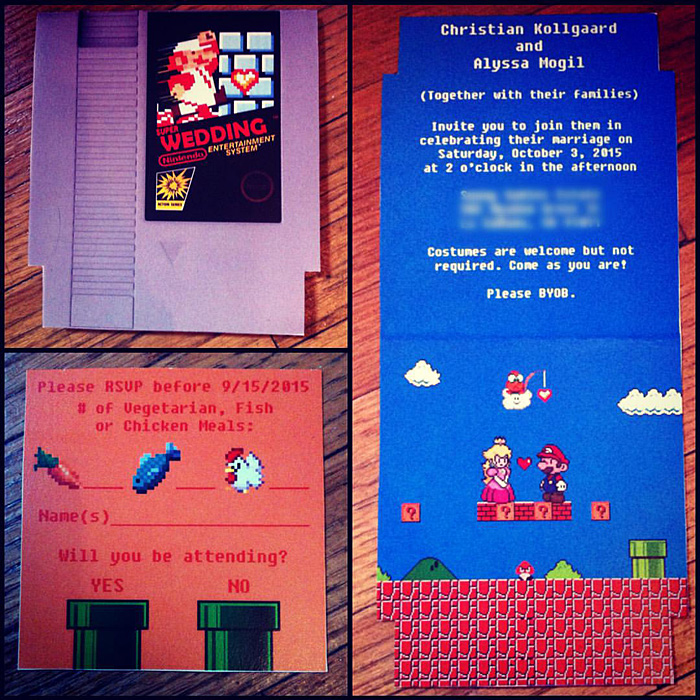

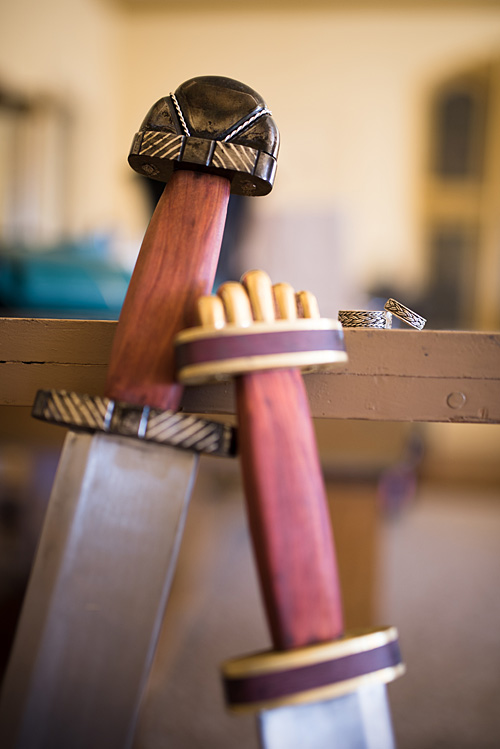








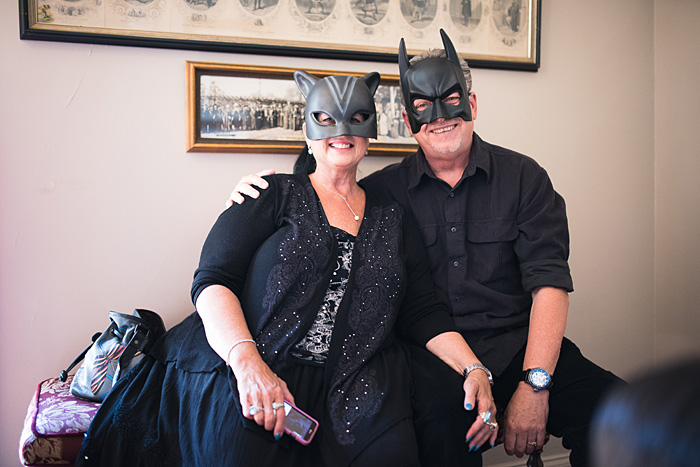

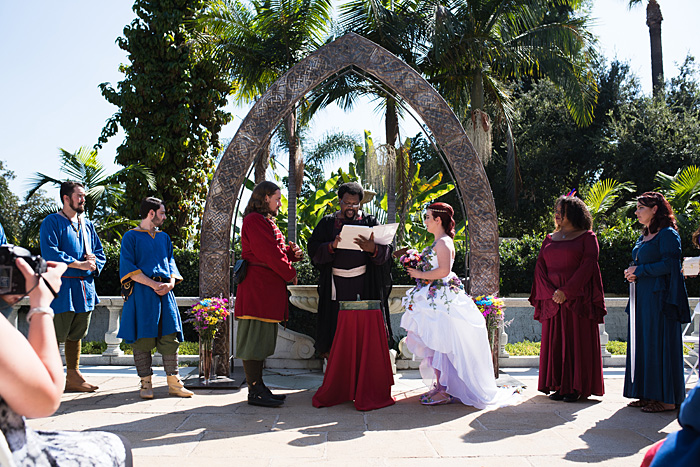

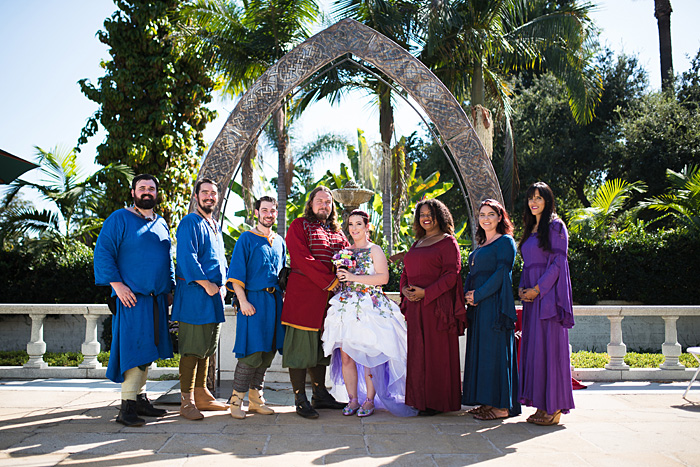
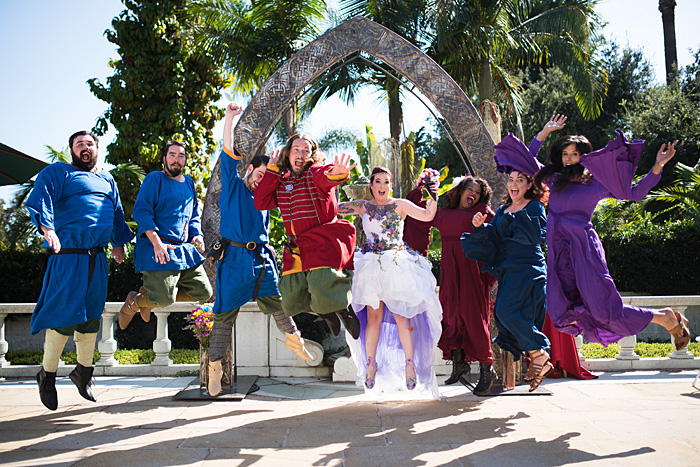

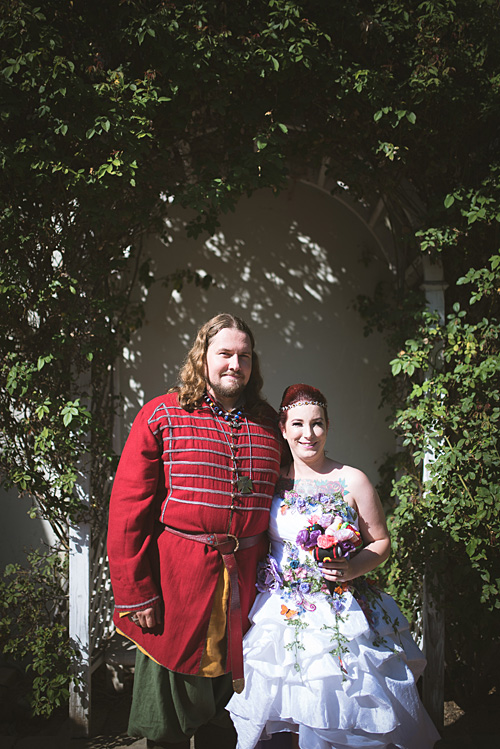


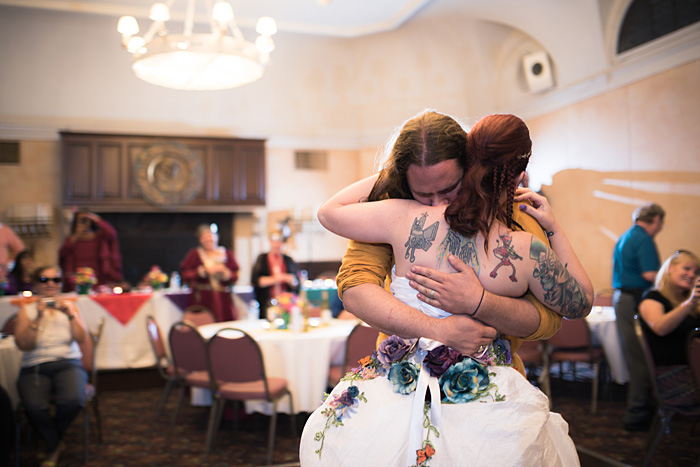


Bride/Article: Geek Girl Mistress Zelda - facebook
Photographer: Stanley Wu Photography
Hair and Makeup: Grotesquery Embrace
DJ: Andrew Paul Holguin / DJ Angelus
Catering: 24 Carat Weddings and Events
Dress: Arabescque
Bride's Shoes: lambsandivydesigns
Bridesmaid's Outfits: Holy Clothing
Groom's Overcoat: Pimp Your Garb
Groom's and Groomsmen's Shoes: Garb the World
Bouquet: whitefrosty
Follow us on:
January 15 2016
Android Pay introduces Rewards, tap 10 times to get a free Chromecast
By now, you’ve likely heard about Android Pay, Google’s tap-and-pay software for mobile payments. Google has been trying some different tactics to encourage usage of Android Pay, with a notable promotion last month in which the company gave $20 Best Buy gift cards to those that tried Android Pay. But now the company is giving customers another incentive to use Android Pay, with Android Pay Rewards.
Android Pay Rewards is a new feature within Android Pay that will reward customers for how often they use Android Pay. On their first tap, they’ll get a free song from Google Play Music. Users will get the same reward on their second and sixth taps. On their 10th tap, however, the rewards really ramp up, with users getting a free Chromecast. Yes, you read that right.
Users will receive a promo code to use in the Google Play Store that will allow them to get their free Chromecast. The promotion runs through February 29, so interested users have a bit of a time to get started with Android Pay. It should be noted that not everyone is seeing the promo yet. It’s arriving as part of the Android Pay update that’s currently rolling, so it may be a couple of days before you see it. When the promo info does appear, it should show up along with your payment, loyalty and gift cards.
Deleted Disney: 'Someday' Hunchback of Notre Dame Cover
Dan JonesI forgot that this song wasn't in the movie, because it's still on the soundtrack, and it's my favorite song from the soundtrack.
Deleted Disney: 'Someday' Hunchback of Notre Dame Cover
Ginny, who is the co-founder of Geekiarchy, a collaborative production company for nerdy web content, sent us this amazing music video! Here's what it's all about...
""Someday" is the fourth release in our series "Deleted Disney", which takes songs that were written for Disney movies but cut before release, and recreates them, live-action, as they might have appeared in the movie. "Someday" is from The Hunchback of Notre Dame (an early precursor to "God Help the Outcasts"), and was cut during storyboarding because composers Alan Menken and Stephen Schwartz wanted a softer song in its place.
This video was shot at Bishop Castle in Rye, CO in one day. It stars Ginny DiGuiseppi (me!), cosplayer and YouTuber. The single will be coming soon to iTunes for purchase."
IllumiBowl Toilet Night Light

The IllumiBowl is a toilet night light that gives you: A) an alternative to blasting your eyes with the overhead light in the bathroom; B) a fun way to help potty train your kids; and C) a better chance of not whizzing on the side of the bowl, the floor, or your bare foot. It also makes your Porcelain God look like the Porcelain God of Disco.
The IllumiBowl apparatus is a palm-sized device that suction cups to the outside rim of your bowl, and then directs its LED color-changing magic inside. The light is motion-activated, so it turns on and off automatically, and each IllumiBowl has 8 light colors, plus a few patterned illuminations to choose from. The pack requires 3 x AAA batteries for operation.
Light up your john with an IllumiBowl Toilet Night Light for 15% off for a limited time from Dude Exclusives.
2-Person Black Jacuzzi

I bet my girlfriend will be my Valentine if I get this sick black jacuzzi bathtub. In fact, I bet all of my girlfriend's girlfriends will also be my Valentine if I get it. Six adjustable massage jets. Eight powerful back jets. Underwater color-changing LED lighting. But I'm afraid this indoor hot tub has only enough space for one special lady alongside me. Just like my heart.
In addition to a bevy of jets and a wash of jet blackness, the 2-person jacuzzi has the following features:
- Air bubble pump and switch controlling 13 air jets
- Heat pump to keep filled tub hot without adding more water
- Computerized LCD screen control panel
- FM Radio with 1 speaker
- Remote control for adjusting jets, radio, and other functions
- Waterfall faucet
- Handheld shower want
- 2 x removable padded waterproof pillows
- An ozone water cleaner to kill any mold, viruses, and bacteria
- Water level sensor
- Thermostatic faucet to ensure precise water temperature
- Also comes in unsexy white
The 2-person black jacuzzi is made of acrylic and an ABS compound material, with 3 layers of glass fiber reinforcement over a stainless steel frame. Dimensions are 72" long x 47" wide x 26" high.






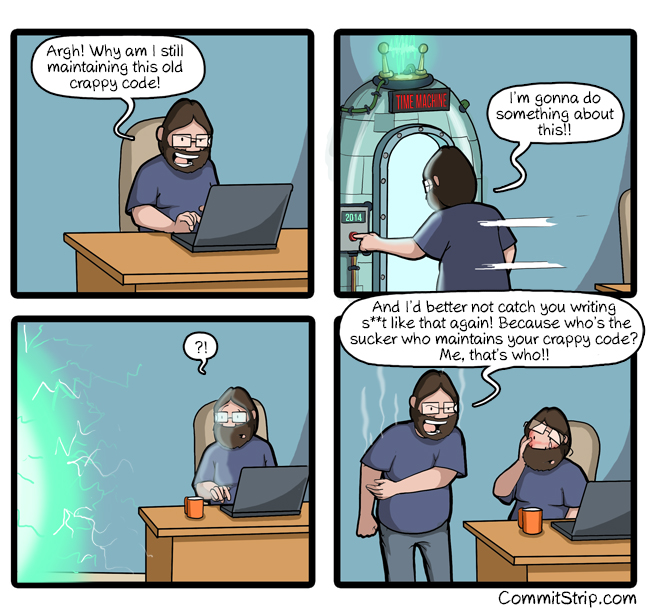
!['--> [ Well, this is embarrassing. ] <--' '--> [ Well, this is embarrassing. ] <--'](http://imgs.xkcd.com/comics/longer_than_usual.png)












